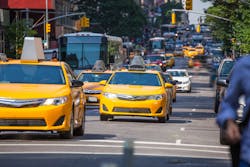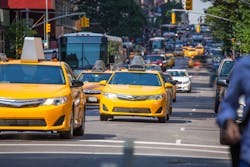Between public & private mobility
The rapid innovation and growth in technology-enabled mobility services has raised many policy issues. To learn more about the services (how they are used, how they relate to established transportation modes, and what implications they have for policy development, regulation, transportation planning and infrastructure investment), the Transportation Research Board (TRB) Executive Committee initiated a study, convening a committee of subject-matter experts through the National Academies of Sciences, Engineering, and Medicine.
The committee’s findings and recommendations are published in TRB Special Report 319, Between Public and Private Mobility: Examining the Rise of Technology-Enabled Transportation Services. The report includes discussion of a variety of mobility services, such as car sharing, bike sharing, taxis and the new app-based ride service companies, known as transportation network companies (TNCs).
Many of the new technology-enabled mobility services are welcome additions for travelers, expanding the world of travel options. TNCs are the most controversial new services, disrupting the regulated for-hire taxi industry and posing a series of challenges to transportation policy makers and regulators. The main challenge is to encourage and facilitate innovations that meet the public’s mobility needs, yet maintain a public policy that is consistent for the new services and the traditional taxi and livery services. At issue is protecting the public interest in matters of safety, driver pay and working conditions, as well as accessibility for people with disabilities.
Addressing this challenge in a rapidly growing and evolving industry requires political will, more information about the scale and nature of the services, and insightful guidance for the evolution of these services to enhance mobility and sustainability.
In the longer term, widespread use of services that involve concurrent vehicle sharing could have implications for business and residential locations as well as for automobile ownership and public transit patronage in ways that could affect the goals of resource-efficient and environmentally sustainable lifestyles. Definitive statements are premature, but the potential benefits and risks of shared mobility services are an important topic for exploration.
Study findings
Innovative mobility services are expanding travel choices and are being widely embraced by millions of travelers.
App-enabled transportation services are among the most remarkable urban transportation innovations in a generation; the technologies deployed for these services are improving mobility in ways that have been proposed and discussed for decades, but never realized on a large scale. Although TNCs have received the greatest media attention, car and bike sharing, employee shuttles, microtransit services, and apps that aggregate all travel options are growing, evolving and affecting travel behavior for many users in profound ways.
Experience suggests that car- and bike-sharing programs in the U.S. reduce personal vehicle travel, emissions, and vehicle ownership. Although travel by innovative mobility services represents a small share of total trips, the programs are having effects on travel behavior, and the continued rapid expansion of their reach and use may significantly affect personal travel in the years ahead.
On its current course, continued expansion of TNCs threatens to exacerbate the “digital divide,” although these services have the potential to enhance mobility for low-income and older adults.
The lack of access to services by those without credit cards or Internet connections is an economy-wide phenomenon, and innovative mobility services are bringing this issue to the forefront for transportation. Most shared mobility services require users to have a credit card on file with the service provider and to arrange service via a smartphone. Substantial numbers of Americans, however, fail to meet one or both of these prerequisites.
Roughly 8% of U.S. households lack bank accounts to qualify for credit cards. Moreover, 36% of Americans currently do not own smartphones, and the rate is higher in some groups—50% among those who earn less than $30,000 annually and 73% among adults over age 65.
Smartphone ownership rates have risen rapidly, but the leveling-off point is not clear, particularly for those with low incomes; the current ownership rates leave substantial portions of the population without access to most shared mobility services. This becomes a greater concern if growth in the new services, such as TNCs, shrinks the availability of options such as taxi services, which can be summoned with a landline or basic mobile phone and which receive payment in cash.
If private providers fail to address these access issues on a broad scale, public agencies and regulatory authorities may turn to regulation, mandates or incentives to make these services fully and equitably available. Shared mobility services have the potential to enhance mobility for disadvantaged populations—the services frequently cost less than taxi services and impose lower up-front costs for travelers than owning a personal vehicle.
Furthermore, if shared- or concurrent-ride TNC services continue to expand and cost less per trip than most traditional door-to-door services, low-income travelers with access may benefit considerably. The expansion of the relatively new multiple-passenger shared-ride options presents an opportunity for even lower-cost door-to-door service—albeit with stops.
Regulated taxis offer critical lifeline transportation services for people with disabilities. Absent some public-policy response, a TNC-fueled decline in taxi services could affect the availability of vehicle-for-hire services to a substantial number of travelers with disabilities.
Roughly 10% of the U.S. population—30.6 million people—have a physical limitation of some kind; 3.6 million use a wheelchair, and another 11.6 million rely on a cane, crutches or a walker. Many cab companies operate wheelchair-accessible vehicles for the general public, sometimes supported through medical providers, social services and Americans with Disabilities Act–mandated paratransit.
8% of U.S. households lack credit-card access, making TNCs, which do not take cash, unusable.
Moreover, several jurisdictions—primarily large cities such as New York, Chicago, and Washington, D.C.—mandate a specified number of wheelchair-accessible taxis, although the efficacy in serving disadvantaged populations is unclear. The more lightly regulated TNCs have introduced pilot programs but have not yet provided wheelchair-accessible services on an extensive or reliable basis. If competition from the increasingly popular TNCs reduces taxi fleets, the near-term result may be fewer door-to-door transportation services for wheelchair users.
Public safety is a central public policy concern with the new shared mobility services.
Regulation traditionally has rectified market failures, such as a lack of information about the safety of vehicles and drivers as well as the quality of the services. Customers of taxi stands and street-hail services, in particular, lack the opportunity to exercise informed choices among providers. Information and communication technologies may have reduced the need for some regulations aimed at service quality, as customers can choose among well-known global brands, and can obtain information about drivers and vehicles before riding. Public safety, however, remains a regulatory concern.
Public entities at the municipal, regional and state levels are implementing public safety regulations for TNCs and other shared mobility services, including regulations on helmet wearing by bike-share users. These evolving regulatory processes, however, reveal a long-standing weakness—the paucity of systematic evaluations of the effectiveness or costs of the current and proposed public safety regulations.
For example, procedures for driver background checks often are based on common practice, but have not been evaluated in a rigorous way. As a result, regulators, the taxi industry and TNC operators may not be following best practices in background checks.
Equally important, minimum limits of automobile liability insurance for taxis, TNCs and other for-hire services vary across jurisdictions and are not based on a systematic analysis of the risks of for-hire operations. Similarly, the technology may facilitate the production and sharing of driver ratings and photos of operators and vehicles, and electronic itineraries may mitigate requirements for certain regulations on service quality and safety, but the benefits have not been documented.
Finally, TNC drivers’ reliance on smartphones may lead to increased distracted driving; this possibility should be examined systematically. In sum, the most effective ways to ensure safe operations of vehicles by safety-conscious drivers, as well as appropriate allocation of the costs imposed by the risk of crashes, remain to be established and deserve careful study.
Like most taxi drivers and workers in the shared economy, TNC drivers are classified by their companies as independent contractors instead of as employees. This status limits their access to benefits that are currently tied to employment.
Independent contractors typically do not receive employer-provided health insurance or employer contributions to Social Security and Medicare, sick leave, workers compensation for injuries, disability insurance, and other employee benefits. Although many drivers report that they value the part-time and transitional employment opportunities at TNCs, some have sued, claiming that the control that the company exerts over them indicates they are employees under federal law.
The TNCs have responded that the drivers are contractors—the company exercises virtually no control over the time or place of trips, and the drivers own the vehicles. Legal precedents under the federal Fair Labor Standards Act, however, involve multiple tests—no single test is determinative.
The legal system is likely to decide this issue. Without state or federal legislation, however, classifying mobility-service contractors as employees would have major ramifications for drivers, company finances and consumer costs.
The vast differences in the scale of TNCs compared with taxi services raise new considerations for regulators.
The rise of multinational corporations that provide taxi-like services in cities around the world contrasts sharply with the structure of the taxi and limousine industries. Although a few taxi fleets are large, regional enterprises, most consist of local firms, fleets of widely varying sizes, and highly varied employment and contractual relationships with drivers. In comparison, the TNCs are a few increasingly large entities that operate globally, which imparts multicity brand awareness and potential market power with customers, drivers and regulators.
In heavily regulated taxi markets, state and local policy makers may need to reduce some constraints, so that taxi and limousine services can compete more effectively. Some aspects of regulation, however—such as labor standards and background checks—may be addressed more logically on a national scale.
Innovations in shared mobility services have the potential to change long-term travel and land use patterns.
By affecting the cost, convenience and flexibility of travel, technology-enabled mobility services may alter travel behavior significantly and land-use patterns potentially. Two possible effects are critical.
First, success in aggregating multiple travelers with similar origins and destinations into a single vehicle will reduce travel costs for users and the negative impacts of vehicle travel. The new services could increase carpooling and ridesharing, which could lead to increased average vehicle occupancies. Ultimately, the reduced vehicle travel could ameliorate automotive externalities such as congestion, nonrenewable energy use and emissions.
Second, by increasing convenient travel alternatives, the new services may encourage lower levels of household vehicle ownership without sacrificing personal mobility. This would eliminate the bias implicit in vehicle ownership toward high-fixed, low-variable costs in mode choice decisions and could spur travel by public transit, walking and biking; this could favor urban instead of suburban residential choices. These changes would have profound effects if automated driving becomes widespread.
On the other hand, less expensive and more convenient travel options encourage more travel and may enhance mobility for dispersed (“sprawl”) locations, increasing the attractiveness to residents and businesses. TNCs and related services, however, are concentrated currently in central, urban locations. In addition, because TNC drivers often travel without passengers between customers, dispersed services could increase total vehicle travel and contribute to congestion, energy consumption and emissions.
Finally, lower fares may draw travelers from public transportation to shared-ride services in large numbers. This too could increase total vehicle miles traveled, emissions and energy consumption. Which of these competing forces will predominate remains to be seen, and the effects may play out in different ways, depending on local circumstances.
Smartphone app-based mobility services will only continue to expand.
Study recommendations
Innovative mobility services already are enhancing mobility for millions and have the potential to yield even greater benefits and to serve other societal goals. To realize the potential of these services, policy makers and regulators will need to address the issues discussed in this report. The committee offers the following recommendations to expand the promise of these services with effective and appropriately scaled public oversight:
1. Policy makers and regulators should formulate public policies and regulations designed to steer the development of innovative services to improve mobility, safety and sustainability;
1a. To the extent that technology features can accomplish the same customer-service protections that previously required regulatory intervention, regulations should be adapted to embrace that opportunity. Local and state governments should reassess current taxi, limousine and (where separately adopted) TNC regulations for market entry, geographic coverage, span of service, and the like in light of these new services as well as the service quality information available to passengers and drivers;
1b. These assessments also should examine public safety requirements for drivers and vehicles, which should be applied in similar fashion across competing industry segments, ensuring consistency and a level playing field;
1c. Similarly, state and local governments should assess how the regulations governing the various industries relate to one another, particularly when multiple jurisdictions regulate different industry segments within the same geographic area. Policy makers and regulators should consider whether traditional for-hire and shared mobility services are best monitored and regulated at the state, regional or local level on the basis of market and service characteristics and regulatory capabilities;
1d. Policy makers and regulators at the state and federal levels should conduct systematic evaluations of safety requirements, examining the core issues of effectiveness and cost;
1e. Given the importance of accessibility for all users (which is frequently operationalized in terms of vehicles that can accommodate wheelchairs), policy makers and regulators should address the potential disparity between access for people with various disabilities and other travelers as these new services expand;
2. Policy makers, planners and regulators should identify the information needed to set policies on, plan for and regulate mobility services, and require this information from all regulated entities;
3. Policy makers and regulators should carefully examine and consider the pros and cons of alternative employment classifications for TNC and taxi drivers; and
4. Policy makers and regulators should seek to integrate the features of TNCs and other innovative shared mobility services into transportation systems and services in ways that leverage the new services’ strengths and features.
Continued transformation
Innovative urban mobility services will continue to evolve, and the research and public policy communities will need to react quickly and in partnership. Use of these and yet-to-be-developed technology-enabled transportation services is likely to continue transforming both passenger and freight travel, and the many stakeholders will need to cooperate to ensure that the outcomes are in the public interest.
Collaboration among these various stakeholders may set precedents, as connected and automated vehicles develop and become common. Addressing this report’s findings can provide a foundation for the technological evolution of the U.S. transportation system.
This article was adapted by the author from TRB Special Report 319.


